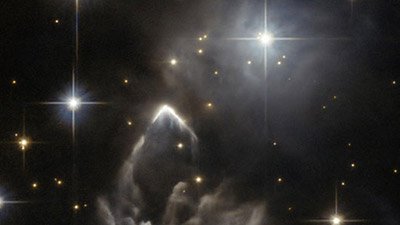Starlight
Distant Starlight
“Hasn’t science demonstrated that it would take billions of years for the light from the farthest galaxies to reach the earth? Doesn’t this disprove the Genesis account or force us to interpret the words differently?” Not at all.
Size of the Universe
Critics of biblical creation sometimes use distant starlight as an argument against a young universe. But when we examine this argument carefully, we see that it does not work. The universe is very big and contains galaxies that are very far away, but that does not mean that the universe must be billions of years old.
Distant Starlight: The Anisotropic Synchrony Convention
Einstein’s theory of relativity launched a new way of looking at the universe. But one question remained: How long does it take light to reach the earth? The answer depends on your assumptions. “Instantly!” declares a new creationist theory.
Articles About Starlight
-
Aug. 28, 2022 from Answers Magazine
The Bible reveals that creation was about 6,000 years ago, so how can we see stars that are millions of light-years away?
-
Feb. 23, 2021 from Answers in Depth
An overview of the light travel time problem, how different biblical creationists have addressed it, and the dasha solution to the problem
-
May 25, 2011 from Answers Magazine
How long does it take light to reach the earth? “Instantly!” declares a new creationist theory.
-
Magazine ArticleDistant StarlightApril 1, 2010 from Answers Magazine
Interestingly, the big bang has a major light-travel problem of its own.
-
Book ChapterDoes Distant Starlight Prove the Universe Is Old?Dec. 13, 2007 from The New Answers Book 1
Critics of biblical creation sometimes use distant starlight as an argument against a young universe. But when we examine this argument carefully, we will see that it does not work.
-
Light Travel-Time ProblemsJune 1, 2007 from Responding to Protestors’ Propaganda
Several assumptions underly the claim that supernovae tens of thousands of light years away indicate an old universe.
-
Are All Stars Within 6,000 Light Years of Earth?May 31, 2007 from Responding to Protestors’ Propaganda
Light years are a measure of distance, not time. Apparently this argument attempts to insinuate that we believe the stars are only 6,000 light years away.
-
Feedback ArticleStellar Evolution, Distant Starlight and Biblical AuthorityJune 2, 2006 from Feedback
Does the size of the universe prove that it must be billions of years old?
-
Feedback ArticleStarlight and Time in Your Classroom!Oct. 14, 2002 from Feedback
have used Dr. Humphreys’ book, Starlight and Time, in a class called ‘Current Issues in Science’, a part of our general education requirements.
-
Technical Research PaperDistant Starlight and Genesis: Conventions of Time MeasurementApril 1, 2001, pp. 80–85
There are two useful conventions to define the time an event occurs: calculated time and observed time.
-
Magazine ArticleThe Velocity of Light and the Age of the UniverseMarch 1, 1981, pp. 38–39
Much modern research in astronomy and physics is built on the assumption that the velocity of light is one of the few things that is truly consistent.
Recommended Resources

Answers in Genesis is an apologetics ministry, dedicated to helping Christians defend their faith and proclaim the good news of Jesus Christ.
- Customer Service 800.778.3390
- Available Monday–Friday | 9 AM–5 PM ET
- © 2025 Answers in Genesis





